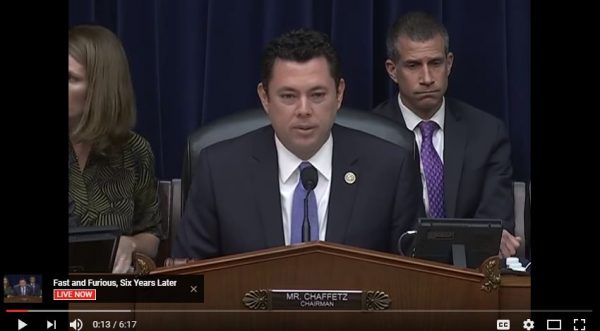
House Oversight Committee Chairman Jason Chaffetz at new Fast & Furious hearing. (YouTube screen capture)
By Dave Workman
Senior Editor
A new report on the Operation Fast and Furious scandal calls the Justice Department’s internal probe of the operation during the Obama administration “largely a sham” that “prioritized politics and spin over public safety.”
The report was prepared for the House Committee on Oversight and Government Reform. It alleges a Justice Department cover-up of Operation Fast and Furious, the Obama administration “gun walking” scandal, which came to an abrupt halt with the slaying of Border Patrol Agent Brian Terry in December 2010. Two guns traced directly to the operation were found at the scene of Terry’s murder, in a gunfight in southern Arizona. The operation was used by the Obama administration to justify new gun reporting requirements in Texas, New Mexico, Arizona and California to fight alleged gun trafficking.
The report, prepared for Congressman Jason Chaffetz, now chair of the Oversight Committee, and Sen. Charles Grassley, chair of the Senate Judiciary Committee, says the “DOJ demonstrated a complete disregard for proper congressional oversight,” according to a Committee news release. “The documents reveal senior Justice Department officials, including the Attorney General, as having a disdain for the congressional oversight function. With support and direction from senior leaders, staff in DOJ’s Office of Legislative Affairs consistently deployed tactics to delay and withhold information from Congress.”
There was more than a little irony in the date. As noted by the Billings Gazette, the report was released five years to the date that then-Attorney General Eric Holder “clashed with Republicans on the House Judiciary Committee seeking more information about the flawed gun-trafficking investigation…”
Holder would eventually be held in contempt of Congress for withholding documents from the Oversight Committee. Then-President Barack Obama ran interference for Holder, extending executive privilege to thousands of documents Holder did not want to turn over to the committee.
Fox News describes the report as “scathing.” It spans about 300 pages.
The operation was exposed initially by online blogger/journalists David Codrea and the late Mike Vanderboegh, and became a hot topic of “gun rights examiners” writing for Examiner.com at the time. Investigative broadcast journalist Sharyl Attkisson’s interview of a whistleblower at the federal Bureau of Alcohol, Tobacco, Firearms and Explosives revealed the scope of the operation to the nation, but later the major networks seemed to ignore the investigation.
The scandal resulted in Oversight Committee hearings, during which one ATF agent described the operation as “the perfect storm of idiocy.”
According to the Committee press release, key takeaways from the report include a revelation that the Justice Department viewed Terry’s family as a “public relations nuisance.” The agency “failed to provide the family with answers regarding Brian’s murder.”
The Committee press release also noted that “There are no documents to demonstrate the Attorney General ever devised a strategy to track down the more than 2,000 firearms lost along the Southwest border. Nor are there any documents to demonstrate the Attorney General coordinated assistance for the Terry family. Instead, documents show Attorney General Holder absorbed in only the political implications of the various milestone events throughout 2011.”
In the report’s Executive Summary, the Committee’s investigation found the following:
“In the course of that investigation, nearly six years ago, the Justice Department wrote to Congress and falsely denied that law enforcement officers allowed straw purchasers to buy firearms illegally in the United States and traffic them without being apprehended. On February 4, 2011, Assistant Attorney General Ron Weich signed a letter that claimed, ‘ATF makes every effort to interdict weapons that have been purchased illegally and prevent their transportation to Mexico.’ Since that false denial, the Committees have investigated why the Department of Justice misled Congress and failed to correct its misrepresentation in a timely manner. Despite the Department’s refusal to cooperate, the investigation developed with the cooperation of DOJ whistleblowers, and especially Acting ATF Director (Ken) Melson’s testimony on July 4, 2011. Although Director Melson testified that the Department deliberately sought to obstruct Congress, prior to the lengthy litigation with the Department in court, the Committees had scant access to most of the documents that corroborate his testimony and illustrate the Department’s tactics in detail.”
Some 2,000 guns were allowed to fall into criminal hands by the ATF, which launched Fast & Furious as a “sting” designed to track those firearms.
The report contains excerpts of emails that reveal strategies about how to deal with Congressional inquiries.
In the wake of the congressional investigation, some people resigned or retired from ATF and others were reassigned.



